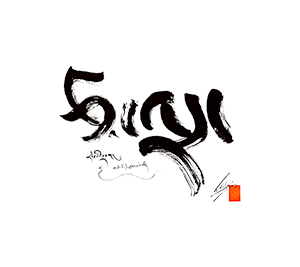Ri chos nges don rgya mtsho zhes bya ba mthar thug thun mong ma yin pa'i man ngag
Dolpopa's seminal work considered to be the most definitive philosophical treatise of the Jonang tradition. It became famous as the crucial source for the presentation of his view of other-emptiness (zhentong).
Philosophical positions of this text
| Other Titles | ~ Ri chos nges don rgya mtsho |
|---|---|
| Text exists in | ~ Tibetan ~ English |
The book emphasizes the Kagyu approach in particular. The author has received teachings from many Kagyu masters and used his knowledge of the tradition as a basis for making this book. He selected teachings from Gampopa and other early masters to set the basis for explaining meditation. Then he added other, necessary teachings according to the extensive teachings he has received over many years from many different Kagyu masters, such as Chogyam Trungpa Rinpoche, Mingyur Rinpoche, and others. The result is a book that explains how to do a complete session of meditation in the style of the Kagyu and Nyingma traditions.
The book begins with a lengthy introduction by Lama Tony which is a teaching in its own right. He writes a lengthy piece about what can and cannot usefully be obtained from science in terms of dharma practice. Following the introduction, there are two chapters on the buddha nature, the second of which uses a significant portion of Dolpopa Sherab Gyaltsen’s explanation of the ground in his famous Mountain Dharma text. This is the first time that this part of Dolpopa’s text has been fully translated and published. After that are several chapters on the various steps of a complete session of meditation. Anyone who practises meditation will find this book useful in many ways.
The book contains a translation of the following text: “Mountain Dharma, An Ocean of Definitive Meaning” by Dolpopa Sherab Gyaltsan, ground section
(Source: Padma Karpo Translations)Kagyu - The Kagyu school traces its origin to the eleventh-century translator Marpa, who studied in India with Nāropa. Marpa's student Milarepa trained Gampopa, who founded the first monastery of the Kagyu order. As many as twelve subtraditions grew out from there, the best known being the Karma Kagyu, the Drikung, and the Drukpa. Tib. བཀའ་བརྒྱུད་
Kagyu - The Kagyu school traces its origin to the eleventh-century translator Marpa, who studied in India with Nāropa. Marpa's student Milarepa trained Gampopa, who founded the first monastery of the Kagyu order. As many as twelve subtraditions grew out from there, the best known being the Karma Kagyu, the Drikung, and the Drukpa. Tib. བཀའ་བརྒྱུད་
Nyingma - The Nyingma, which is often described as the oldest tradition of Tibetan Buddhism, traces its origin to Padmasambhava, who is said to have visited Tibet in the eighth century. Tib. རྙིང་མ་
Kagyu - The Kagyu school traces its origin to the eleventh-century translator Marpa, who studied in India with Nāropa. Marpa's student Milarepa trained Gampopa, who founded the first monastery of the Kagyu order. As many as twelve subtraditions grew out from there, the best known being the Karma Kagyu, the Drikung, and the Drukpa. Tib. བཀའ་བརྒྱུད་
Kagyu - The Kagyu school traces its origin to the eleventh-century translator Marpa, who studied in India with Nāropa. Marpa's student Milarepa trained Gampopa, who founded the first monastery of the Kagyu order. As many as twelve subtraditions grew out from there, the best known being the Karma Kagyu, the Drikung, and the Drukpa. Tib. བཀའ་བརྒྱུད་
Dzogchen - Dzogchen is an advanced system of meditation techniques to reveal the innate state of perfection primarily, but not exclusively, espoused by the Nyingma Buddhist tradition and the Tibetan Bön tradition. Skt. महासन्धि Tib. རྫོགས་ཆེན།
gzhan stong - The state of being devoid of that which is wholly different rather than being void of its own nature. The term is generally used to refer to the ultimate, or buddha-nature, being empty of other phenomena such as adventitious defiling emotions but not empty of its true nature. Tib. གཞན་སྟོང་
śūnyatā - The state of being empty of an innate nature due to a lack of independently existing characteristics. Skt. शून्यता Tib. སྟོང་པ་ཉིད་ Ch. 空,空門
This Text on Adarsha - If it doesn't load here, refresh your browser.
The wikipage input value is empty (e.g. <code>, [[]]</code>) and therefore it cannot be used as a name or as part of a query condition.
Jonang - The Jonang tradition was established by Dölpopa Sherab Gyaltsen, a thirteenth-century Sakya monk famous for his Zhentong teachings. The Jonang teachings and monasteries were suppressed in Tibet in the seventeenth century but survived in Amdo. Tib. ཇོ་ནང་
gzhan stong - The state of being devoid of that which is wholly different rather than being void of its own nature. The term is generally used to refer to the ultimate, or buddha-nature, being empty of other phenomena such as adventitious defiling emotions but not empty of its true nature. Tib. གཞན་སྟོང་
gzhan stong - The state of being devoid of that which is wholly different rather than being void of its own nature. The term is generally used to refer to the ultimate, or buddha-nature, being empty of other phenomena such as adventitious defiling emotions but not empty of its true nature. Tib. གཞན་སྟོང་

